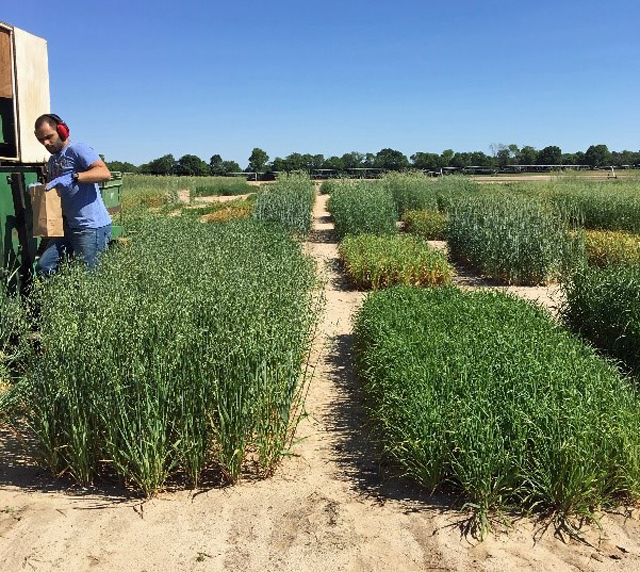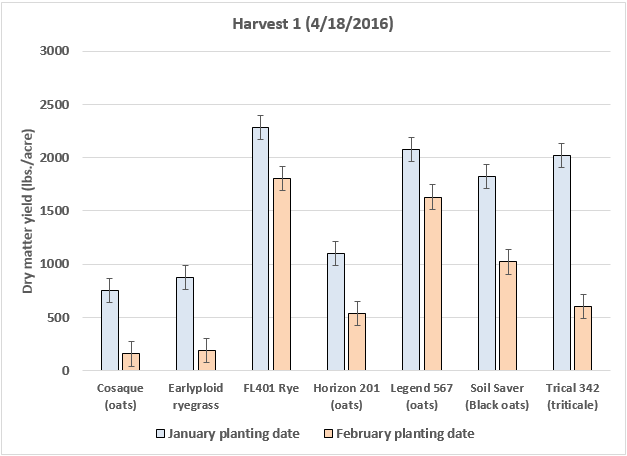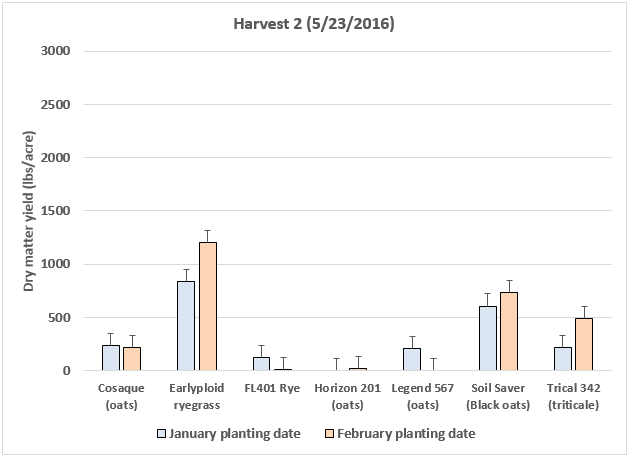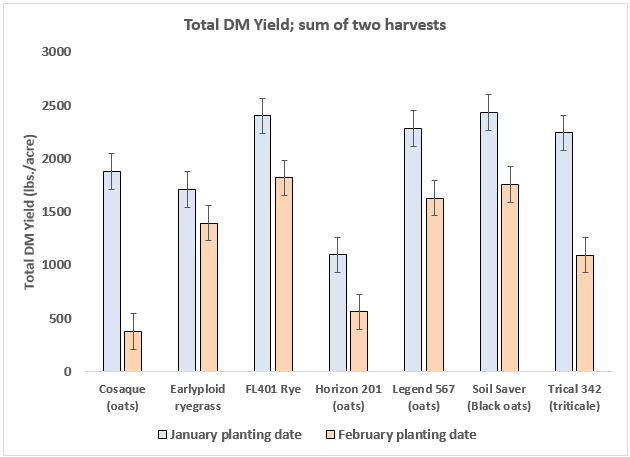Jose Dubeux, A. Blount, C. Mackowiak, E. Santos, D. Jaramillo, L. Garcia, J. Pereira Neto, L. Dantas
Things do not always happen according to plan, especially this fall for cool-season forage planting. The recommended planting period of cool-season grasses in North Florida ranges from October 15th to November 15th. However, this year North Florida suffered a severe drought during this planting window. Unless the producer had irrigation available, cool-season forage plantings were delayed. For many counties in North Florida, rainfall did not return until the last day of November. Many producers have asked if it was still worthwhile to plant cool-season grasses, or if it would be better just to buy hay and feed? There is not enough information available on late planting of cool-season forage yields, so people rely on past experience and hearsay to help guide their decisions.
As part of the forage research program at the North Florida Research and Education Center, researchers are investigating uncommon planting dates to fill the forage gaps that normally occur from October to December and from April to June in North Florida. In order to help fill these gaps, they are testing a strategy of late-planted cool-season forages (January and February planting) to fill the traditional April-June forage gap. They are also conducting trials to fill the other gap, October-December, with early plantings in late August or early September. This information is also relevant for producers hit by the atypical weather (drought) like this Fall.
Researchers planted a variety of cool-season grasses, including annual ryegrass (Earlyplod), cereal rye (FL401), oats (Cosaque, Legend 567, and Horizon 201), triticale (Trical 342), and black oats (Soil Saver). These grasses were planted on two dates: January 19 and February 18, 2016. Seeding rates used were: Oats-100 lbs./a, Triticale-85 lbs./a, cereal rye-65 lbs./a, black oats-60 lbs./a, and annual ryegrass-18 lbs./a. Differing seed rates were calculated from seed size and desired plant population. Harvests occurred in April (4/18/2016; Figure 1) and May (5/23/2016).

Figure 1. Harvest of late-planted (January and February) cool-season forages;
first harvest occurred April 18, 2016; UF/IFAS NFREC, Marianna, FL.
As expected, planting in January was better than planting in February for all forages. In general, earlier late plantings should yield better. In the first harvest (April 18, 2016), small grain cultivars (FL401 rye, Legend 567 oats, Soil Saver black oats, and Trical 342 triticale) produced more biomass than annual ryegrass. Cosaque and Horizon 201 oats had severe yield declines because of rust infection. The February planting resulted in lower production, due to the shorter growing season and increased rust infection. The best forage options for a January planting were FL401 rye, Legend 567 oats, Soil Saver black oats, and Trical 342 triticale (Figure 2).

Figure 2. Dry matter yield of cool-season grasses planted in January or February 2016 in North Florida (UF/IFAS NFREC, Marianna, FL). Data from first harvest (4/18/2016).
In the second harvest (May 23, 2016), forages produced less biomass compared to the first harvest, except for annual ryegrass which produced more (Figure 3). This is typically expected for annual ryegrass, which is later maturing and benefits from longer days. Other cultivars were either severely attacked by rust (Cosaque, Horizon 201), were early maturing (FL 401, Legend 567), or were suffering from high May temperatures. One exception is the black oat variety Soil Saver, which outperformed the other tested small grains by the second harvest. Black oats (Avena strigosa) tend to have good heat tolerance.

Figure 3. Dry matter yield of cool-season grasses planted in January or February 2016 in North Florida (UF/IFAS NFREC, Marianna, FL). Data from second harvest (5/23/2016).
Total biomass yield (sum of two harvests) of late-planted cool-season forages are summarized in Figure 4. The January planting resulted in greater yields than the February planting, for all cultivars. Yield reduction was more pronounced for Cosaque and Horizon 201 oats, mostly because of a severe rust attack on the February planting. Small grains, in general, produced more biomass than annual ryegrass, once they reach heading. Later maturing cultivars were not tested, nor a blend of small grains and ryegrass plants in the same plot. That might be a good strategy for maximizing yields. Forage samples are still being evaluated for nutritive value, which might indicate differences in digestibility among the cultivars.

Figure 4. Dry matter yield of cool-season grasses planted in January or February 2016 in North Florida (UF/IFAS NFREC, Marianna, FL). Data from two harvests (April and May).
Take Home Message
The ideal time to plant cool-season grasses in North Florida this year has come and gone. Based on the preliminary results, from only the first year of this trial, it is possible to plant these forages later in the season and still produce a ton of feed /acre; however, forage production will be reduced, mainly because of the shorter growing season. There is also a risk of an early hard freeze, but even so, good-quality forage can still be produced this year. Livestock producers need to take into consideration the planting costs and the benefit they get with cool-season forages and compare with other options, such as purchasing hay and feed. Although annual ryegrass had a lower seed cost, it was not as productive as the small grains last year. Black oats require a lower seed rate than regular oats, and might be a good option since the cultivar tested in this trial was ranked among the top cultivars. If planting regular oats, Legend 567 should be considered because of its rust resistance, while older oat varieties might succumb. Cereal rye is also an option, but forage nutritive value will likely be lower, compared to other options. Although it was not part of this trial, annual ryegrass mixed with other small grains might provide greater seasonal forage yield, with earlier season small grains yields shifting to later season ryegrass yields.
- 2025 UF/IFAS Forage Legume Conference – May 1 - March 28, 2025
- How are My Cool-season Forages Recovering from the Snowfall and Low Temperatures? - January 31, 2025
- Integrated Crop-Livestock Systems Improve Soil Health - July 26, 2024
